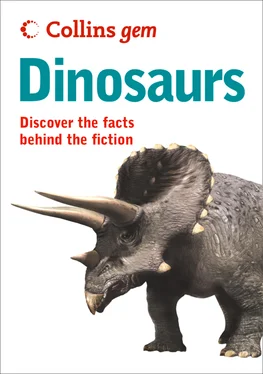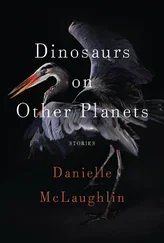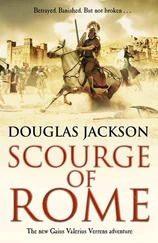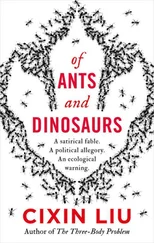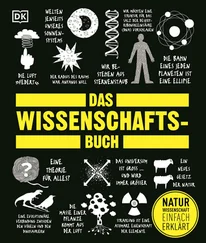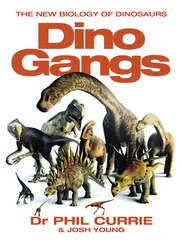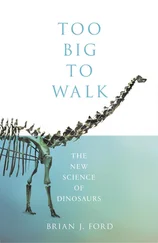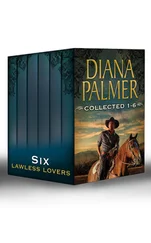
Dinosaurs.
COPYRIGHT CONTENTS. Cover . Title Page . Copyright . Note to Readers .
.
HarperCollins Publishers Ltd. 1 London Bridge Street,. London SE1 9GF.
WilliamCollinsBooks.com.
First published in 2006.
This edition published in 2014.
Text © 2006 Douglas Palmer.
Illustrations © 2006 HarperCollins Publishers .
The author asserts his moral right to be identified as the author of this work.
Illustrations by James Robins and Steve White (pages 10 Caption: A crocodile, a living relative of the dinosaurs. The closest living relatives to the dinosaurs are the birds and crocodiles, with which they share certain features. All three groups share the presence of extra openings in the skull and jaw. With the birds they have in common lightly built bones, the bony structure of their legs, a hinged ankle, and aspects of the skull and jaws. And while the dinosaurs are also similar to crocodiles, they differ from them and other reptiles in the bone structure of their legs, feet and hips. Crocodiles, like most other living reptiles, sprawl with their limbs held out to the side of the body. However, the dinosaurs have their limbs tucked in under the body, a structure that allows them to walk and run more efficiently. The image and idea of dinosaurs as once living animals has changed enormously since their fossil remains were first discovered and recognized as belonging to a distinct group of extinct reptiles. Even the iconic status of the giant meat eaters like Tyrannosaurus rex has been partly displaced by that of small, fast-moving and highly active predators, some of which are known to have been covered with hairlike down and feathers. Caption: Archaeopteryx , a feathered dinosaur descendant.
, 13 Caption:. Bodybuilding: Velociraptor skeleton and musculature. Caption: Stegosaurus , with its distinctive bony back plates. Detailed study of fossil bones can also indicate the presence of other features such as where muscles attached and how big they were, and where blood vessels and nerves ran. The thickness of a bone’s wall and its interior structure indicate how strong it was and whether it could carry a heavy body or was instead adapted for swimming or flight. Sometimes, fossil skeletons are found that are nearly complete and have their various bones still articulated in their true anatomical positions. Such discoveries have helped confirm what anatomists have predicted, but they have also sometimes led to surprises. Some dinosaur structures are so original and unusual that they cannot easily be predicted by comparative anatomy. For instance, what exactly the back plates of a Stegosaurus and the hand claws of a Therizinosaurus were used for is still something of a puzzle. Very occasionally, imprints or mineralized soft tissues are preserved that show that a particular dinosaur had a scaly skin or a feather-like covering. Even internal organs such as the gut and stomach contents have been preserved in some instances, giving important clues as to how the animals lived. Caption: The dome on the skull of Pachycephalosaurus could be up to 25cm (10in) thick.
, 18 Caption: Meat-eaters: a Tyrannosaurus rex skull and its cutting teeth. Small insect-eating dinosaurs, for example, needed only small, sharp, conical teeth that were strong enough to crunch the insects up. In contrast, large predatory dinosaurs that required lots of meat had large teeth that were powerful and sharp enough to kill their prey and then remove as much flesh as quickly as possible before other predators and scavengers were attracted to the kill. Some of these teeth had sophisticated cutting edges with serrations like those on a steak knife. Plant-eating dinosaurs displayed an even greater variety in the form of their teeth depending upon the kind of plant material they ate. Many of the giant sauropods had strange peg-like teeth that probably worked like rakes, stripping large amounts of foliage from branches as the animal’s long neck swept from side to side and up and down. Other herbivores ate much tougher fibrous plants and had large, strong, leaf-shaped teeth that were gradually worn away and eventually replaced. Since flowering plants did not evolve until Cretaceous times around 100 million years ago, the food available to herbivorous dinosaurs included more basic groups of plants such as ferns, conifers, cycads, horsetails and ginkgos. Many of these plants were difficult to digest and had low nutritional value. Like many herbivorous mammals today, the plant-eating dinosaurs had large stomachs and had to eat constantly to obtain enough nutrition from their diet. As an aid to digestion, some of them swallowed stones that then acted as a gastric mill along with their stomach flora of digestive bacteria. But large size slows an animal down, so how did the giant herbivores protect themselves from predators? Caption: Plant-eater: Iguanodon and details of its grinding teeth.
, 21 Caption: A nesting Psittacosaurus dinosaur with babies. Dinosaur eggs ranged in size and shape from tiny round eggs to long oval-shaped ones more than 50cm (20in) long and around 4.0l (8.5pts) in volume. These were, however, small compared to the biggest bird egg, which was laid by the extinct Elephant Bird ( Aepyornis ) and measured more than 1m (3ft) in circumference and 7.3l (15.4pts) in volume. Large eggs need thick shells but these also have to be porous to allow the foetus to ‘breathe’. Consequently, dinosaur eggs could not be too large. Like modern- day turtles, many dinosaurs laid large numbers of eggs because relatively few of the babies would survive into adulthood. In the 1970s, finds from the so-called Egg Mountain site in Montana, USA, revealed what may have been a shared nesting ground and hatchery for the duck-billed dinosaur Maiasaura . Several nests up to 2m (6.6ft) wide have been found, made of layers of plant material and mud topped by a hollow in which up to 12 eggs were laid. The 9m-long (30ft) mother was far too big to have sat on the eggs but probably would have fed her babies, which could not have looked after themselves to begin with. In contrast, hatchlings of the small theropod Troodon , which also nested around Egg Mountain, were much more precocious and probably began to feed themselves very early on. Surprisingly, there is evidence that even some of the biggest plant-eating sauropods stayed around their nests for some time, presumably to try to protect the eggs and babies from predators. Caption: A Mussaurus hatchling. Some of the skeletons of this species could fit into the palm of a hand.
, 23 Caption: A Mussaurus hatchling. Some of the skeletons of this species could fit into the palm of a hand.
, 25 Caption: A Repenomamus with a baby Psittacosaurus . Medium-sized plant eaters that were neither fast movers nor well armoured developed other means of defending themselves against predators. The hadrosaurs, for example, were equipped with a variety of strange bony structures on their skulls, some of which may have been used to amplify calls to other members of the herd to warm against a nearby predator. And, finally, we now know that dinosaurs did not have it all their own way. Recently, the fossil of a badger-sized mammal called Repenomamus has been found with the remains of a baby psittacosaur in its stomach cavity. Caption: Brachiosaurus , quite possibly too large for most predators.
, 27 TRACKS AND TRAILS . When dinosaur footprints were first seriously studied they presented a considerable puzzle. Footprints and tracks found in the early 19th century in Massachusetts, USA, were initially seen as evidence for the Old Testament Flood.
Читать дальше
